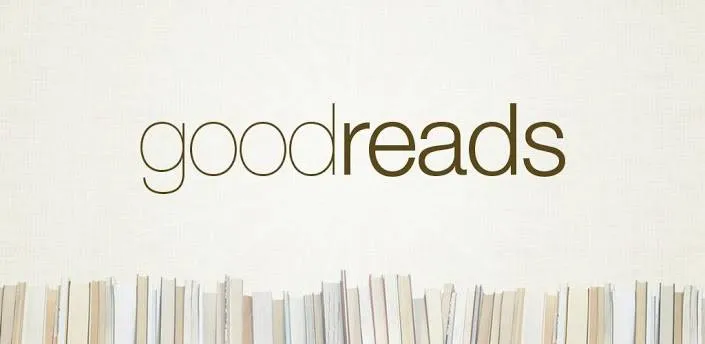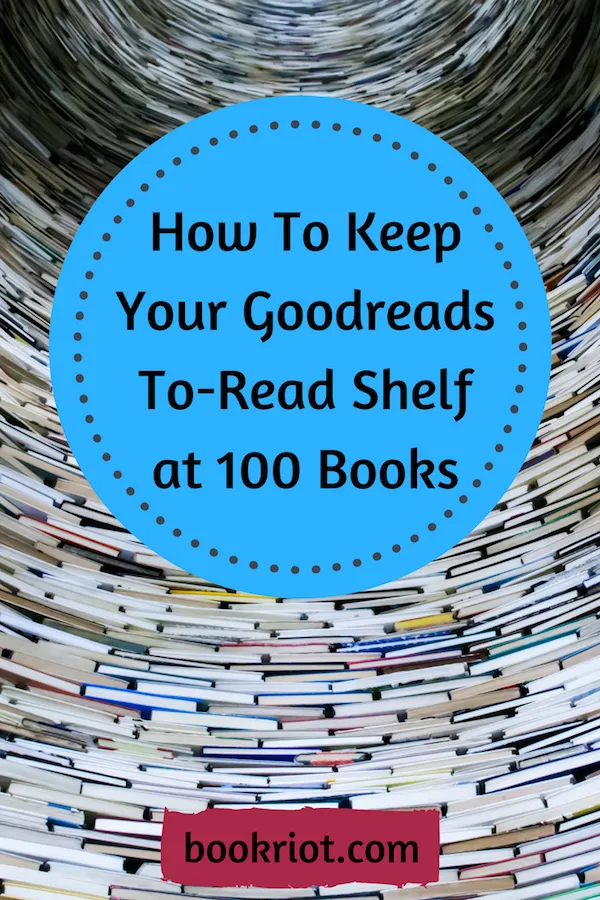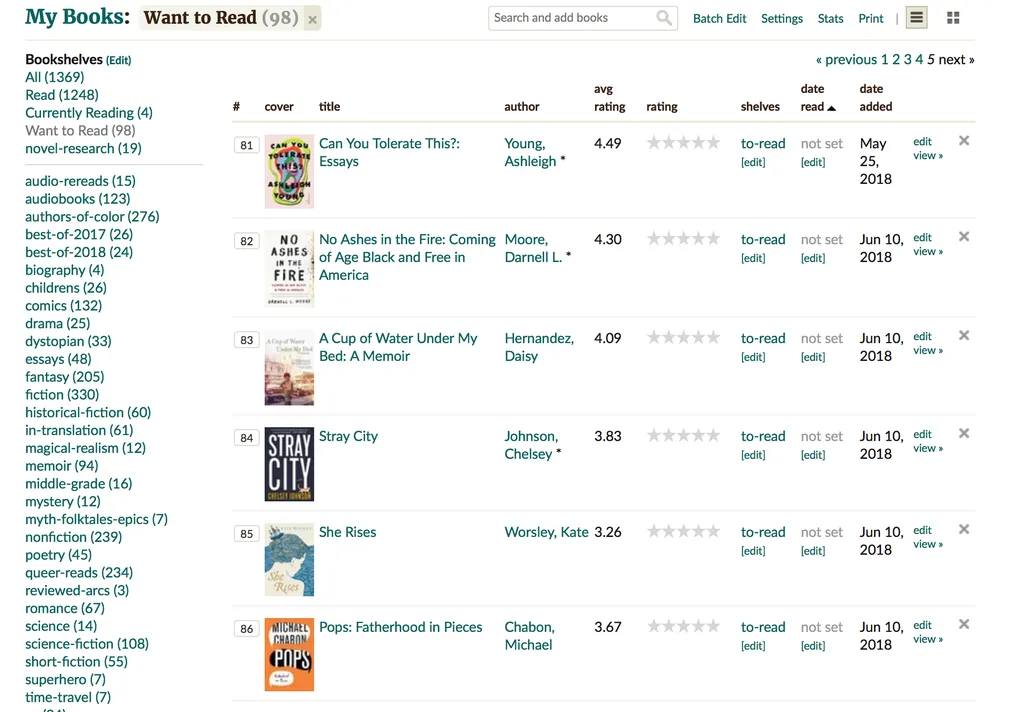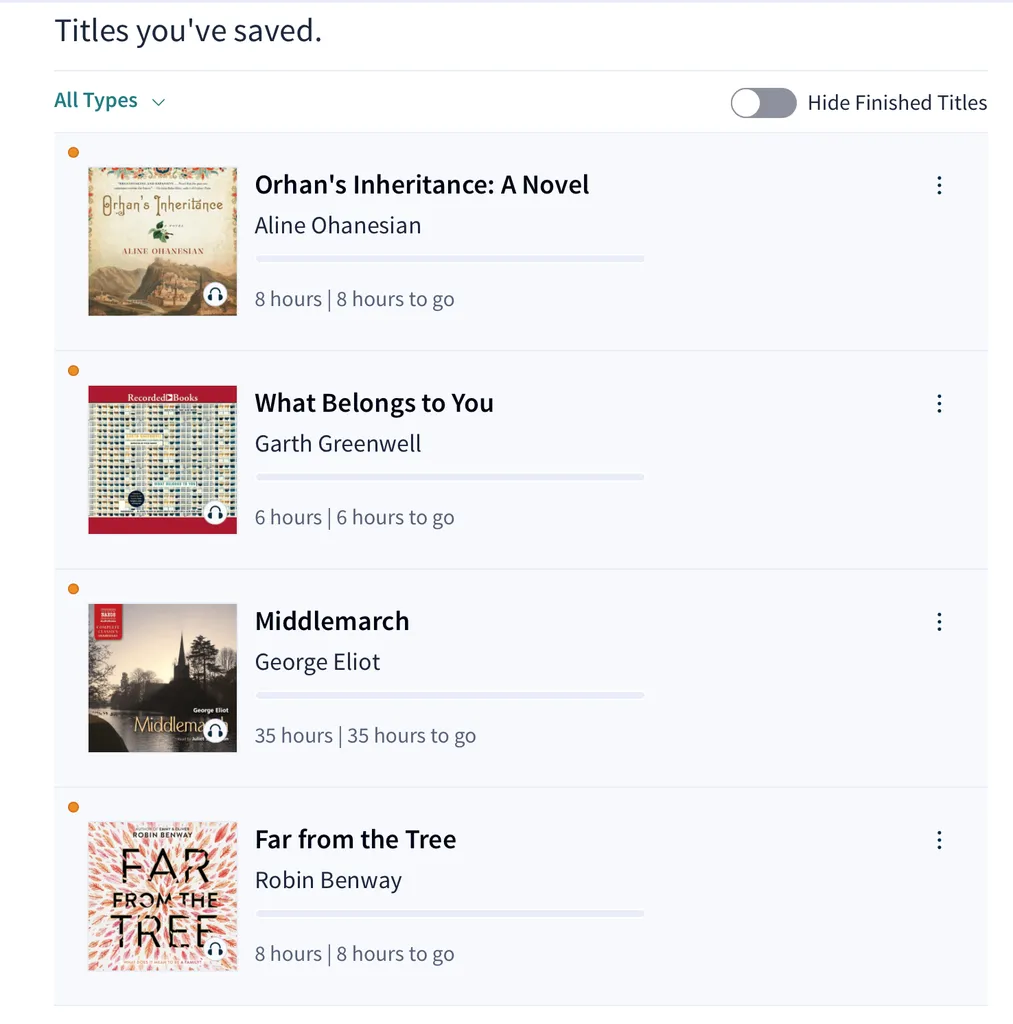
How (And Why) I Keep My Goodreads To-Read Shelf at 100 Books
Every reader has a different relationship with their TBR pile. Some readers keep a physical stack of unread books next to their bed. Some don’t have a TBR at all. Many readers, myself included, use the want-to-read shelf on Goodreads. Many of my Goodreads friends have hundreds or even thousands of books on their to-read shelf. I can understand why—every time I scroll through my feed, I’m tempted to add more books to the shelf. But I don’t, because of a simple rule: I keep my Goodreads to-read shelf at 100 books.
 The thought of having more than 100 books on my to-read shelf gives me anxiety. There are, of course, more than 100 books that I want to read. But a list of over 100 books just isn’t useful. It’s too big for me to navigate easily. What good is a TBR list if it just stresses me out?
As soon as I imposed this limit on my to-read shelf, its usefulness drastically increased. No longer do books sit there languishing in an ever-growing digital pile. The shelf remains constant at 100, but the books on it constantly change. Because of the 100-book limit, I have to remove a book from the shelf every time I want to add one to it. It’s a dynamic list that reflects what I actually want to read, not what I wanted to read five years ago. I’m actively culling books that no longer hold my interest, and I’m actively reading books that I’m genuinely excited about.
The thought of having more than 100 books on my to-read shelf gives me anxiety. There are, of course, more than 100 books that I want to read. But a list of over 100 books just isn’t useful. It’s too big for me to navigate easily. What good is a TBR list if it just stresses me out?
As soon as I imposed this limit on my to-read shelf, its usefulness drastically increased. No longer do books sit there languishing in an ever-growing digital pile. The shelf remains constant at 100, but the books on it constantly change. Because of the 100-book limit, I have to remove a book from the shelf every time I want to add one to it. It’s a dynamic list that reflects what I actually want to read, not what I wanted to read five years ago. I’m actively culling books that no longer hold my interest, and I’m actively reading books that I’m genuinely excited about.
 Say a friend recommends a book to me. You’ll Love This Book sounds fantastic, but I’m already in the middle of a book. I go to add You’ll Love This Book to my to-read shelf so I don’t forget about it, but there’s already 100 books on the list! What do I do?
If you’re wondering how to keep your Goodreads to-read shelf small, here are the steps I take to limit mine to 100 books:
Say a friend recommends a book to me. You’ll Love This Book sounds fantastic, but I’m already in the middle of a book. I go to add You’ll Love This Book to my to-read shelf so I don’t forget about it, but there’s already 100 books on the list! What do I do?
If you’re wondering how to keep your Goodreads to-read shelf small, here are the steps I take to limit mine to 100 books:
 These two steps might not work for all readers, but you can tweak them to suit your own reading habits. Maybe there’s another genre you always read electronically, or books you know you want to buy. The idea is to take a closer look at the book you want to add to your to-read shelf, and ask: is putting this book on this list the most useful way for me to remember it?
But what happens when there’s nothing I want to take off my to-read shelf, and You’ll Love This Book isn’t a romance or a book I want to listen to on audio? Now comes the most fun part of this whole ritual:
These two steps might not work for all readers, but you can tweak them to suit your own reading habits. Maybe there’s another genre you always read electronically, or books you know you want to buy. The idea is to take a closer look at the book you want to add to your to-read shelf, and ask: is putting this book on this list the most useful way for me to remember it?
But what happens when there’s nothing I want to take off my to-read shelf, and You’ll Love This Book isn’t a romance or a book I want to listen to on audio? Now comes the most fun part of this whole ritual:
 The thought of having more than 100 books on my to-read shelf gives me anxiety. There are, of course, more than 100 books that I want to read. But a list of over 100 books just isn’t useful. It’s too big for me to navigate easily. What good is a TBR list if it just stresses me out?
As soon as I imposed this limit on my to-read shelf, its usefulness drastically increased. No longer do books sit there languishing in an ever-growing digital pile. The shelf remains constant at 100, but the books on it constantly change. Because of the 100-book limit, I have to remove a book from the shelf every time I want to add one to it. It’s a dynamic list that reflects what I actually want to read, not what I wanted to read five years ago. I’m actively culling books that no longer hold my interest, and I’m actively reading books that I’m genuinely excited about.
The thought of having more than 100 books on my to-read shelf gives me anxiety. There are, of course, more than 100 books that I want to read. But a list of over 100 books just isn’t useful. It’s too big for me to navigate easily. What good is a TBR list if it just stresses me out?
As soon as I imposed this limit on my to-read shelf, its usefulness drastically increased. No longer do books sit there languishing in an ever-growing digital pile. The shelf remains constant at 100, but the books on it constantly change. Because of the 100-book limit, I have to remove a book from the shelf every time I want to add one to it. It’s a dynamic list that reflects what I actually want to read, not what I wanted to read five years ago. I’m actively culling books that no longer hold my interest, and I’m actively reading books that I’m genuinely excited about.
 Say a friend recommends a book to me. You’ll Love This Book sounds fantastic, but I’m already in the middle of a book. I go to add You’ll Love This Book to my to-read shelf so I don’t forget about it, but there’s already 100 books on the list! What do I do?
If you’re wondering how to keep your Goodreads to-read shelf small, here are the steps I take to limit mine to 100 books:
Say a friend recommends a book to me. You’ll Love This Book sounds fantastic, but I’m already in the middle of a book. I go to add You’ll Love This Book to my to-read shelf so I don’t forget about it, but there’s already 100 books on the list! What do I do?
If you’re wondering how to keep your Goodreads to-read shelf small, here are the steps I take to limit mine to 100 books:
Are there any books I can delete off my Goodreads to-read shelf?
The first step is always to scroll through my to-read shelf, in case there are any books on it that I’m no longer interested in reading. The goal is for my to-read shelf to be full of 100 books I simply cannot wait to read. If there’s a book on there that’s no longer exciting me, I ditch it favor of You’ll Love This Book.Is there a book on my Goodreads to-read shelf that I can put on hold at the library instead?
I like to pick out what to read next spontaneously, based on my current mood. When making space for a new book on my Goodreads to-read shelf, I don’t necessarily want to start reading a book off the list immediately. This is why I love books with long library waits. I can switch a book from my to-read shelf to my library holds list without worrying about the book arriving the next day. When there’s nothing I want to delete unread from my to-read shelf or put on hold at the library, it’s time to make a closer look at You’ll Love This Book.Is you’ll Love This Book a romance?
I read books in all forms: digital, print, and audio, but I read romance almost exclusively on my kindle. I generally having a romance novel going that I read before bed, and it’s nice to be able to just turn off the lights and read on my kindle until I fall asleep. If You’ll Love This Book is a romance, I download a sample, bypassing my to-read shelf altogether.Do I want to listen to You’ll Love This Book on audio?
I listen to a ton of audiobooks, which I get from two sources: the library (via Libby) or Scribd. Both of these platforms have features that allow me to save books I want to read later. If I’ve heard great things about the audio of You’ll Love This Book, I add it to my saved list on one of those platforms. This makes it easy and fun to pick my next audiobook. These two steps might not work for all readers, but you can tweak them to suit your own reading habits. Maybe there’s another genre you always read electronically, or books you know you want to buy. The idea is to take a closer look at the book you want to add to your to-read shelf, and ask: is putting this book on this list the most useful way for me to remember it?
But what happens when there’s nothing I want to take off my to-read shelf, and You’ll Love This Book isn’t a romance or a book I want to listen to on audio? Now comes the most fun part of this whole ritual:
These two steps might not work for all readers, but you can tweak them to suit your own reading habits. Maybe there’s another genre you always read electronically, or books you know you want to buy. The idea is to take a closer look at the book you want to add to your to-read shelf, and ask: is putting this book on this list the most useful way for me to remember it?
But what happens when there’s nothing I want to take off my to-read shelf, and You’ll Love This Book isn’t a romance or a book I want to listen to on audio? Now comes the most fun part of this whole ritual:









